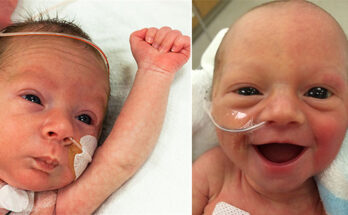“When we found out we were pregnant again in July 2017, we were surprised, but had no idea just how surprised we were going to be. I had felt ‘pregnant for about 2 weeks but thought maybe I was just imagining things since two of our friends had just told us they were expecting. When we finally got the confirmation that we would be adding to our family in March 2018, that’s when the rest of the surprises began.”
She could tell something was different from the start of her second pregnancy. The 25-year-old mother anticipated having strange food cravings and gain weight. Instead, she became unable to eat and began to lose weight.
Taylor also experienced some minor setbacks, such as aches in unusual locations and nosebleeds. However, on the day of the delivery, she was finally well-rested and in great health. Everyone in the delivery room, however, was taken aback when she gave birth to a girl.
This was the moment all the different thoughts started swarming in. Taylor and her husband, Chris were terrified and greatly concerned about their daughter’s health. Soon, they made an appointment with a genetic specialist who confirmed the diagnosis – albinism.
Neither Taylor nor Chris had a family history of the condition, so they were completely confused. Still, it was a relief for them to know that, despite the diagnosis, their daughter was healthy.
You probably know what albinism is, because it’s a pretty well-known condition. This rare group of genetic disorders affects the hair, skin, and eyes, causing them to have either no or little color. It also may have a psychological effect because Albinos may experience taunts and bullying.
Little Noralynn will most likely need corrective lenses and sunscreen. But other than that, she’s OK.
Besides, they didn’t even have to explain to their oldest child, daughter Brooklyn, why her sister was different. It turns out that the 5-year-old thinks Noralynn is magical.
It’s not as uncommon as you would imagine giving birth to an albino. Recife’s Rosemere Fernanda de Andrade made news when she gave birth to her third child with albinism. Three of her offspring now have white complexion and blonde hair, while the other three, like their parents, are black.
Albinism does not mean that Noralynn is less human than others. It is just that she looks slightly different than those around her who have darker hair and eyes.
Such children teach us to accept that everyone is unique and different in a special way.
This is definitely going to be a different journey than they had planned for, but it’s going to be okay. Having albinism is okay. Being different is okay. Having Noralynn has opened their eyes in so many ways, learning to accept that everyone is different and unique in their own special way.”










